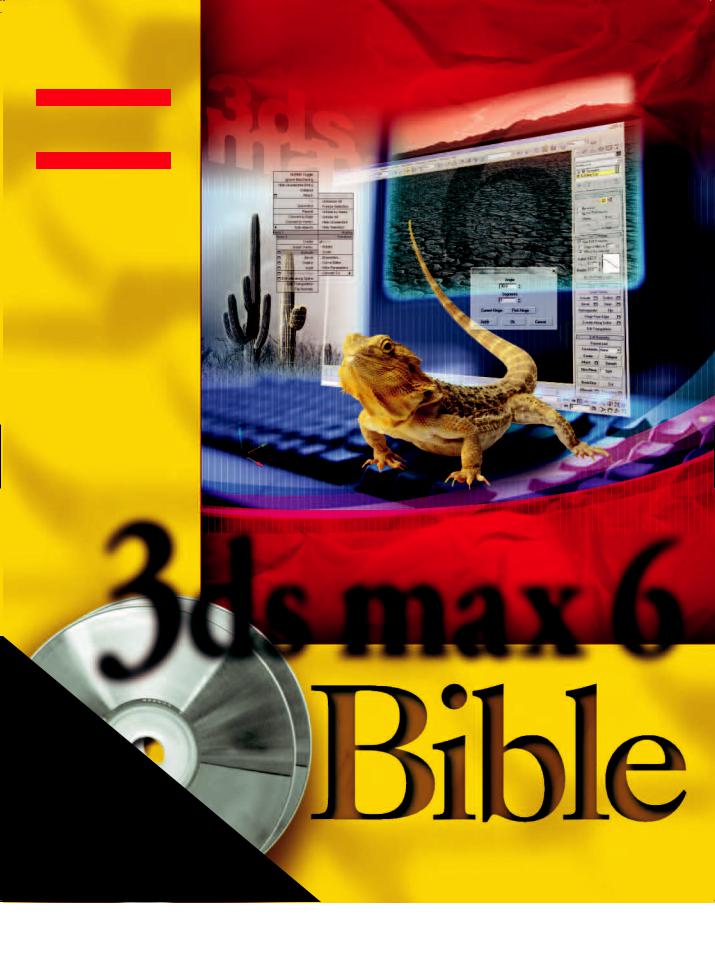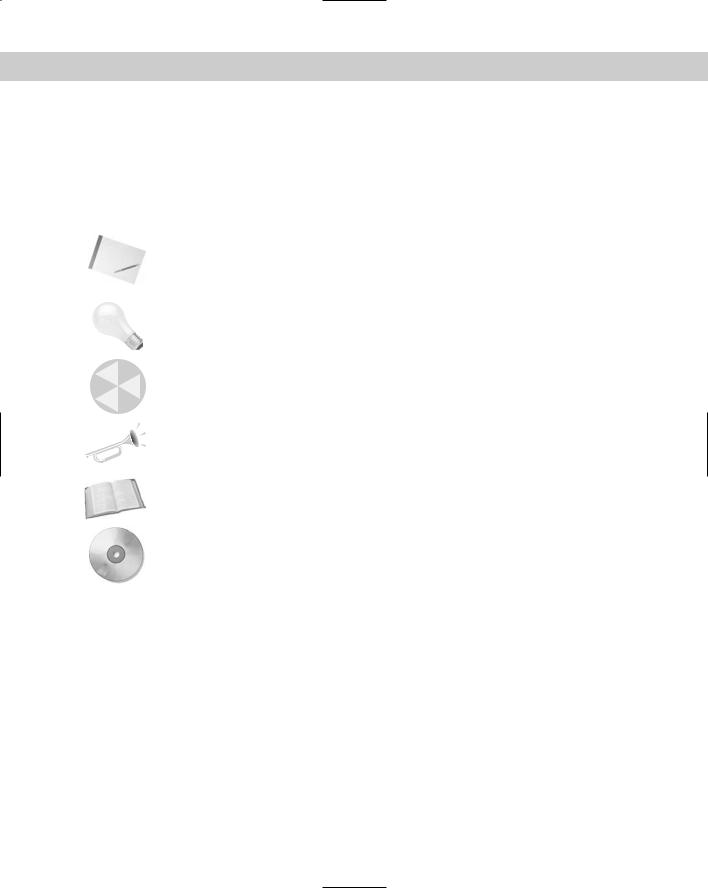
- •Preface
- •About This Book
- •Acknowledgments
- •Contents at a Glance
- •Contents
- •Relaxing at the Beach
- •Dressing the Scene
- •Animating Motion
- •Rendering the Final Animation
- •Summary
- •The Interface Elements
- •Using the Menus
- •Using the Toolbars
- •Using the Viewports
- •Using the Command Panel
- •Using the Lower Interface Bar Controls
- •Interacting with the Interface
- •Getting Help
- •Summary
- •Understanding 3D Space
- •Using the Viewport Navigation Controls
- •Configuring the Viewports
- •Working with Viewport Backgrounds
- •Summary
- •Working with Max Scene Files
- •Setting File Preferences
- •Importing and Exporting
- •Referencing External Objects
- •Using the File Utilities
- •Accessing File Information
- •Summary
- •Customizing Modify and Utility Panel Buttons
- •Working with Custom Interfaces
- •Configuring Paths
- •Selecting System Units
- •Setting Preferences
- •Summary
- •Creating Primitive Objects
- •Exploring the Primitive Object Types
- •Summary
- •Selecting Objects
- •Setting Object Properties
- •Hiding and Freezing Objects
- •Using Layers
- •Summary
- •Cloning Objects
- •Understanding Cloning Options
- •Mirroring Objects
- •Cloning over Time
- •Spacing Cloned Objects
- •Creating Arrays of Objects
- •Summary
- •Working with Groups
- •Building Assemblies
- •Building Links between Objects
- •Displaying Links and Hierarchies
- •Working with Linked Objects
- •Summary
- •Using the Schematic View Window
- •Working with Hierarchies
- •Setting Schematic View Preferences
- •Using List Views
- •Summary
- •Working with the Transformation Tools
- •Using Pivot Points
- •Using the Align Commands
- •Using Grids
- •Using Snap Options
- •Summary
- •Exploring the Modifier Stack
- •Exploring Modifier Types
- •Summary
- •Exploring the Modeling Types
- •Working with Subobjects
- •Modeling Helpers
- •Summary
- •Drawing in 2D
- •Editing Splines
- •Using Spline Modifiers
- •Summary
- •Creating Editable Mesh and Poly Objects
- •Editing Mesh Objects
- •Editing Poly Objects
- •Using Mesh Editing Modifiers
- •Summary
- •Introducing Patch Grids
- •Editing Patches
- •Using Modifiers on Patch Objects
- •Summary
- •Creating NURBS Curves and Surfaces
- •Editing NURBS
- •Working with NURBS
- •Summary
- •Morphing Objects
- •Creating Conform Objects
- •Creating a ShapeMerge Object
- •Creating a Terrain Object
- •Using the Mesher Object
- •Working with BlobMesh Objects
- •Creating a Scatter Object
- •Creating Connect Objects
- •Modeling with Boolean Objects
- •Creating a Loft Object
- •Summary
- •Understanding the Various Particle Systems
- •Creating a Particle System
- •Using the Spray and Snow Particle Systems
- •Using the Super Spray Particle System
- •Using the Blizzard Particle System
- •Using the PArray Particle System
- •Using the PCloud Particle System
- •Using Particle System Maps
- •Controlling Particles with Particle Flow
- •Summary
- •Understanding Material Properties
- •Working with the Material Editor
- •Using the Material/Map Browser
- •Using the Material/Map Navigator
- •Summary
- •Using the Standard Material
- •Using Shading Types
- •Accessing Other Parameters
- •Using External Tools
- •Summary
- •Using Compound Materials
- •Using Raytrace Materials
- •Using the Matte/Shadow Material
- •Using the DirectX 9 Shader
- •Applying Multiple Materials
- •Material Modifiers
- •Summary
- •Understanding Maps
- •Understanding Material Map Types
- •Using the Maps Rollout
- •Using the Map Path Utility
- •Using Map Instances
- •Summary
- •Mapping Modifiers
- •Using the Unwrap UVW modifier
- •Summary
- •Working with Cameras
- •Setting Camera Parameters
- •Summary
- •Using the Camera Tracker Utility
- •Summary
- •Using Multi-Pass Cameras
- •Creating Multi-Pass Camera Effects
- •Summary
- •Understanding the Basics of Lighting
- •Getting to Know the Light Types
- •Creating and Positioning Light Objects
- •Viewing a Scene from a Light
- •Altering Light Parameters
- •Working with Photometric Lights
- •Using the Sunlight and Daylight Systems
- •Using Volume Lights
- •Summary
- •Selecting Advanced Lighting
- •Using Local Advanced Lighting Settings
- •Tutorial: Excluding objects from light tracing
- •Summary
- •Understanding Radiosity
- •Using Local and Global Advanced Lighting Settings
- •Working with Advanced Lighting Materials
- •Using Lighting Analysis
- •Summary
- •Using the Time Controls
- •Working with Keys
- •Using the Track Bar
- •Viewing and Editing Key Values
- •Using the Motion Panel
- •Using Ghosting
- •Animating Objects
- •Working with Previews
- •Wiring Parameters
- •Animation Modifiers
- •Summary
- •Understanding Controller Types
- •Assigning Controllers
- •Setting Default Controllers
- •Examining the Various Controllers
- •Summary
- •Working with Expressions in Spinners
- •Understanding the Expression Controller Interface
- •Understanding Expression Elements
- •Using Expression Controllers
- •Summary
- •Learning the Track View Interface
- •Working with Keys
- •Editing Time
- •Editing Curves
- •Filtering Tracks
- •Working with Controllers
- •Synchronizing to a Sound Track
- •Summary
- •Understanding Your Character
- •Building Bodies
- •Summary
- •Building a Bones System
- •Using the Bone Tools
- •Using the Skin Modifier
- •Summary
- •Creating Characters
- •Working with Characters
- •Using Character Animation Techniques
- •Summary
- •Forward versus Inverse Kinematics
- •Creating an Inverse Kinematics System
- •Using the Various Inverse Kinematics Methods
- •Summary
- •Creating and Binding Space Warps
- •Understanding Space Warp Types
- •Combining Particle Systems with Space Warps
- •Summary
- •Understanding Dynamics
- •Using Dynamic Objects
- •Defining Dynamic Material Properties
- •Using Dynamic Space Warps
- •Using the Dynamics Utility
- •Using the Flex Modifier
- •Summary
- •Using reactor
- •Using reactor Collections
- •Creating reactor Objects
- •Calculating and Previewing a Simulation
- •Constraining Objects
- •reactor Troubleshooting
- •Summary
- •Understanding the Max Renderers
- •Previewing with ActiveShade
- •Render Parameters
- •Rendering Preferences
- •Creating VUE Files
- •Using the Rendered Frame Window
- •Using the RAM Player
- •Reviewing the Render Types
- •Using Command-Line Rendering
- •Creating Panoramic Images
- •Getting Printer Help
- •Creating an Environment
- •Summary
- •Creating Atmospheric Effects
- •Using the Fire Effect
- •Using the Fog Effect
- •Summary
- •Using Render Elements
- •Adding Render Effects
- •Creating Lens Effects
- •Using Other Render Effects
- •Summary
- •Using Raytrace Materials
- •Using a Raytrace Map
- •Enabling mental ray
- •Summary
- •Understanding Network Rendering
- •Network Requirements
- •Setting up a Network Rendering System
- •Starting the Network Rendering System
- •Configuring the Network Manager and Servers
- •Logging Errors
- •Using the Monitor
- •Setting up Batch Rendering
- •Summary
- •Compositing with Photoshop
- •Video Editing with Premiere
- •Video Compositing with After Effects
- •Introducing Combustion
- •Using Other Compositing Solutions
- •Summary
- •Completing Post-Production with the Video Post Interface
- •Working with Sequences
- •Adding and Editing Events
- •Working with Ranges
- •Working with Lens Effects Filters
- •Summary
- •What Is MAXScript?
- •MAXScript Tools
- •Setting MAXScript Preferences
- •Types of Scripts
- •Writing Your Own MAXScripts
- •Learning the Visual MAXScript Editor Interface
- •Laying Out a Rollout
- •Summary
- •Working with Plug-Ins
- •Locating Plug-Ins
- •Summary
- •Low-Res Modeling
- •Using Channels
- •Using Vertex Colors
- •Rendering to a Texture
- •Summary
- •Max and Architecture
- •Using AEC Objects
- •Using Architectural materials
- •Summary
- •Tutorial: Creating Icy Geometry with BlobMesh
- •Tutorial: Using Caustic Photons to Create a Disco Ball
- •Summary
- •mental ray Rendering System
- •Particle Flow
- •reactor 2.0
- •Schematic View
- •BlobMesh
- •Spline and Patch Features
- •Import and Export
- •Shell Modifier
- •Vertex Paint and Channel Info
- •Architectural Primitives and Materials
- •Minor Improvements
- •Choosing an Operating System
- •Hardware Requirements
- •Installing 3ds max 6
- •Authorizing the Software
- •Setting the Display Driver
- •Updating Max
- •Moving Max to Another Computer
- •Using Keyboard Shortcuts
- •Using the Hotkey Map
- •Main Interface Shortcuts
- •Dialog Box Shortcuts
- •Miscellaneous Shortcuts
- •System Requirements
- •Using the CDs with Windows
- •What’s on the CDs
- •Troubleshooting
- •Index

100%
O N E H U N D R E D P E R C E N T
C O M P R E H E N S I V E A U T H O R I T A T I V E W H A T Y O U N E E D
O N E H U N D R E D P E R C E N T
“Kelly’s“Kelly’s newnew bookbook indeedindeed deservesdeserves toto bebe calledcalled aa BibleBible.. ItsIts comprehensivenesscomprehensiveness andand levellevel ofof detaildetail areare quitequite remarkableremarkable..””
——ChrisChris Ford,Ford, DirectorDirector ofof ProductProduct Management,Management, 3D3D Animation,Animation, Discreet/AutodeskDiscreet/Autodesk
Plunge right into 3ds max with the exciting Quick Start project in Part 1
Explore reactor 2, mental ray, Particle Flow, BlobMesh, and other revolutionary new features
Master the use of inverse kinematics, space warps, raytracing, and other
techniques3ds max™ 6
BONUS
CD-ROMS
Including a demo version of
3ds max 6, tutorial files, 3D models, and a searchable PDF version of the book showing all examples in color
Kelly L. Murdock

3ds max™ 6 Bible
Kelly L. Murdock

3ds max™ 6 Bible
Published by
Wiley Publishing, Inc.
111 River Street Hoboken, N.J. 07030-5774 www.wiley.com
Copyright 2004 by Wiley Publishing, Inc., Indianapolis, Indiana
Published simultaneously in Canada
ISBN: 0-7645-5763-7
Manufactured in the United States of America
10 9 8 7 6 5 4 3 2 1
1B/SU/QT/QU/IN
No part of this publication may be reproduced, stored in a retrieval system or transmitted in any form or by any means, electronic, mechanical, photocopying, recording, scanning or otherwise, except as permitted under Sections 107 or 108 of the 1976 United States Copyright Act, without either the prior written permission of the Publisher, or authorization through payment of the appropriate per-copy fee to the Copyright Clearance Center, 222 Rosewood Drive, Danvers, MA 01923, (978) 750-8400, fax (978) 750-8600. Requests to the Publisher for permission should be addressed to the Legal Department, Wiley Publishing, Inc., 10475 Crosspoint Blvd., Indianapolis, IN 46256, (317) 572-3447, fax (317) 572-4447, E-Mail: permcoordinator@wiley.com.
THE PUBLISHER AND THE AUTHOR MAKE NO REPRESENTATIONS OR WARRANTIES WITH RESPECT TO THE ACCURACY OR COMPLETENESS OF THE CONTENTS OF THIS WORK AND SPECIFICALLY DISCLAIM ALL WARRANTIES, INCLUDING WITHOUT LIMITATION WARRANTIES OF FITNESS FOR A PARTICULAR PURPOSE. NO WARRANTY MAY BE CREATED OR EXTENDED BY SALES OR PROMOTIONAL MATERIALS. THE ADVICE AND STRATEGIES CONTAINED HEREIN MAY NOT BE SUITABLE FOR EVERY SITUATION. THIS WORK IS SOLD WITH THE UNDERSTANDING THAT THE PUBLISHER IS NOT ENGAGED IN RENDERING LEGAL, ACCOUNTING, OR OTHER PROFESSIONAL SERVICES. IF PROFESSIONAL ASSISTANCE IS REQUIRED, THE SERVICES OF A COMPETENT PROFESSIONAL PERSON SHOULD BE SOUGHT. NEITHER THE PUBLISHER NOR THE AUTHOR SHALL BE LIABLE FOR DAMAGES ARISING HEREFROM. THE FACT THAT AN ORGANIZATION OR WEBSITE IS REFERRED TO IN THIS WORK AS A CITATION AND/OR A POTENTIAL SOURCE OF FURTHER INFORMATION DOES NOT MEAN THAT THE AUTHOR OR THE PUBLISHER ENDORSES THE INFORMATION THE ORGANIZATION OR WEBSITE MAY PROVIDE OR RECOMMENDATIONS IT MAY MAKE. FURTHER, READERS SHOULD BE AWARE THAT INTERNET WEBSITES LISTED IN THIS WORK MAY HAVE CHANGED OR DISAPPEARED BETWEEN WHEN THIS WORK WAS WRITTEN AND WHEN IT IS READ.
For general information on our other products and services or to obtain technical support, please contact our Customer Care Department within the U.S. at (800) 762-2974, outside the U.S. at (317) 572-3993 or fax (317) 572-4002.
Wiley also publishes its books in a variety of electronic formats. Some content that appears in print may not be available in electronic books.
Library of Congress Cataloging-in-Publication Data: 2004103174
Trademarks: Wiley and the Wiley Publishing logo are trademarks or registered trademarks of John Wiley and Sons, Inc. and/or its affiliates. 3ds max is a trademark or registered trademark of Autodesk, Inc. All other trademarks are the property of their respective owners. Wiley Publishing, Inc. is not associated with any product or vendor mentioned in this book.
is a trademark of Wiley Publishing, Inc.

About the Author
Kelly Murdock has been authoring computer books for many years now and still gets immense enjoyment from the completed work. His book credits include various Web, graphics, and multimedia titles, including three previous editions of this book, 3ds max 6 Bible. Other major accomplishments include Master VISUALLY HTML and XHTML, JavaScript Visual Blueprint, gmax Bible, Adobe Atmosphere Bible, and co-authoring duties on two editions of the Illustrator Bible (for versions 9 and 10).
With a background in engineering and computer graphics, Kelly has been all over the 3D industry and still finds it fascinating. He’s used high-level CAD workstations for product design and analysis, completed several large-scale visualization projects, created 3D models for feature films, worked as a freelance 3D artist, and even done some 3D programming. Kelly’s been using 3D Studio since version 3 for DOS.
In his spare time, Kelly enjoys the outdoors while rock climbing, mountain biking, or skiing. He has recently formed a design company with his brother, Chris, called Logical Paradox Design.

Credits
Acquisitions Editor |
Project Coordinator |
|
Tom Heine |
April Farling |
|
Project Editor |
Graphics and Production Specialists |
|
Martin V. Minner |
Carrie Foster |
|
Technical Editor |
Lauren Goddard |
|
Joyce Haughey |
||
Chris Murdock |
Jennifer Heleine |
|
Copy Editor |
LeAndra Hosier |
|
Michael Kruzil |
||
Gwenette Gaddis Goshert |
Kristin McMullan |
|
Editorial Manager |
Lynsey Osborn |
|
Quality Control Technicians |
||
Robyn Siesky |
||
Vice President and Executive Group |
John Greenough |
|
Susan Moritz |
||
Publisher |
Angel Perez |
|
Richard Swadley |
Senior Permissions Editor |
|
Vice President and Executive |
||
Carmen Krikorian |
||
Publisher |
Media Development Specialist |
|
Robert Ipsen |
||
Vice President and Publisher |
Greg Stafford |
|
Proofreading and Indexing |
||
Barry Pruett |
||
|
TECHBOOKS Production Services |
|
|
Cover Image |
|
|
Anthony Stuart |
|
|
Special Help |
|
|
Adrienne Porter |

I tweak the light settings for weeks, but it still doesn’t match the light in your eyes.
I scan and layer a hundred photos, but it still doesn’t capture the details of your soft skin.
I apply every controller and animation technique, but it still can’t portray the intricacies of your tiny smile.
I load hundreds of sound files, but it still isn’t equal to the synchronization of your little laugh.
I render thousands of times, and still I’m amazed at the work of the Master Animator.
To Max, 2003


Preface
Whenever I withdrew to the computer room, my wife would say that I was off to my “fun and games.” I would flatly deny this accusation, saying that it was serious work that I was involved in. But later, when I emerged with a twinkle in my eye and excitedly asked her to take a look at my latest rendering, I knew that she was right. Working with 3D graphics is pure “fun and games.”
My goal in writing this book was to take all my fun years of playing in 3D and boil them down into something that’s worthwhile for you — the reader. This goal was compounded by the fact that all you Max-heads out there are at different levels. Luckily, this book is thick enough to include a little something for everyone.
The audience level for the book ranges from beginning to intermediate, with a smattering of advanced topics for the seasoned user. If you’re new to Max, then you’ll want to start at the beginning and move methodically through the book. If you’re relatively comfortable making your way around Max, then review the table of contents for sections that can enhance your fundamental base. If you’re a seasoned pro, then you’ll want to watch for coverage of the features new to Release 6.
If you’re so excited to be working with Max that you can’t decide where to start, then head straight for the Quick Start. The Quick Start is a single chapter-long tutorial that takes you through the creation of an entire scene and animation. This Quick Start was included in response to some feedback from readers of the first edition who complained that they didn’t know where to start. For those of you who were too anxious to wade through a mountain of material before you could create something, this Quick Start is for you.
Another goal of this book is to make it a complete reference for Max. To achieve this goal, I’ve gone into painstaking detail to cover almost every feature in Max, including coverage of every primitive, material and map type, modifier, and controller.
As this book has come together, I’ve tried to write the type of book that I’d like to read. I’ve tried to include a variety of scenes that are infused with creativity. It is my hope that these examples will not only teach you how to use the software, but also provide a creative springboard for you in your own projects. After all, that’s what turns 3D graphics from work into “fun and games.”
Who Is Max?
Max is coming of age. Now with the number 6 attached to its name, it is starting to show some maturity. I’d say that version numbers are akin to dog years, which would place Max in its early 40s.
Before we go any further, I should explain my naming convention. The official name of the product in this release is 3ds max 6 with a lowercase m, but I simply refer to it as Max with a capital M. This reference is a nickname given to a piece of software that has become more familiar to me than the family pets (whose names are Fuzzy, Curious, and Parakeetsta, by the way). Note: I have not been successful in training Max to come when I call or to sit on command, but it will on occasion play dead.
One way we humans develop our personalities is to incorporate desirable personality traits from those around us. Max’s personality is developing as well — every new release has incorporated a plethora of desirable new features. Many of these features come from the many additional plug-ins being developed to enhance Max. With Release 6, many features that were available as plug-ins for previous releases have been adopted by Max. Several new features have been magically assimilated into the core product, such as mental ray. These additions make Max’s personality much more likable, like a human developing a sense of humor.

viii |
3ds max 6 Bible |
Other personality traits are gained by stretching in new directions. Max and its developers have accomplished this feat as well. Many of the new features are completely new, not only to Max, but to the industry, such as the Particle Flow interface. As Max grows up, it will continue to mature by adopting new features and inventing others. I just hope Max doesn’t experience a mid-life crisis in the next version.
About This Book
Let me paint a picture of the writing process. It starts with years of experience, which is followed by months of painstaking research. There were system crashes and personal catastrophes and the always-present, ever-looming deadlines. I wrote into the early hours of the morning and during the late hours of the night — burning the candle at both ends and in the middle all at the same time. It was grueling and difficult, and spending all this time staring at the Max interface made me feel like .
. . well . . . like an animator.
Sound familiar? This process actually isn’t much different from what 3D artists, modelers, and animators do on a daily basis, and, like you, I find satisfaction in the finished product.
Tutorials aplenty
I’ve always been a very visual learner — the easiest way for me to gain knowledge is by doing things for myself while exploring at the same time. Other people learn by reading and comprehending ideas. In this book, I’ve tried to present information in a number of ways to make the information usable for all types of learners. That is why you see detailed discussions of the various features along with tutorials that show these concepts in action.
The tutorials appear throughout the book and are clearly marked with the “Tutorial” label in front of the title. They always include a series of logical steps, typically ending with a figure for you to study and compare. These tutorial examples are provided on the book’s CD-ROM to give you a firsthand look and a chance to get some hands-on experience.
I’ve attempted to “laser focus” all the tutorials down to one or two key concepts. This means that you probably will not want to place the results in your portfolio. For example, many of the early tutorials don’t have any materials applied because I felt that using materials before they’ve been explained would only confuse you.
I’ve attempted to think of and use examples that are diverse, unique, and interesting, while striving to make them simple, light, and easy to follow. I’m happy to report that every example in the book is included on the CD-ROM along with the models and textures required to complete the tutorial.
The tutorials often don’t start from scratch, but instead give you a starting point. This approach lets me “laser focus” the tutorials even more; and with fewer, more relevant steps, you can learn and experience the concepts without the complexity. On the book’s CD-ROM, you will find the Max files that are referenced in Step 1 of most tutorials.
I’ve put lots of effort into this book, and I hope it helps you in your efforts. I present this book as a starting point. In each tutorial, I’ve purposely left most of the creative spice out, leaving room for you to put it in — you’re the one with the vision.
Fourth time around
This book is now in its fourth edition and, like aged cheddar cheese, is getting better with time. This edition posed an interesting dilemma. The edition for Max 4 clocked in at 1,246 pages, which was the largest number of pages that can be bound into a paperback book. So, for Max 5, I needed to rework and tighten the content to make room for pages where the new features could be covered, which was an tough task, but I was happy to say I succeeded by cramming in an additional 400 pages worth of content into the 3ds max 5 Bible. However, when the book came back from the printer, it weighed in at only 1,106 pages, making the reader think that the book was put on a diet. It turned out that the editors who laid out the book decided to use a tighter layout, thereby saving 140 pages while providing the additional content.

Preface ix
Now that I’m working on a version covering Max 6, I’m delighted to have that extra 140 pages to cram full of information, and the editors are already looking at an even tighter format. At this rate, the next couple of editions will be shipping with a magnifying glass.
There have been several other changes to this edition. In an effort to add some new life to many of the older tutorials (several of which desired a chance to retire), I have secured a new set of Viewpoint models that I’ve used to replace many of the old tutorials. I’ve also included a new Quick Start that lets you play with a monster truck.
How this book is organized
Many different aspects of 3D graphics exist, and in some larger production houses, you might be focused on only one specific area. However, for smaller organizations or the general hobbyist, you end up wearing all the hats — from modeler and lighting director to animator and post-production compositor. This book is organized to cover all the various aspects of 3D graphics, regardless of the hat on your head.
The book is divided into the following parts:
Quick Start — This single chapter (which is actually a chapter in Part I) is an entire animation project presented in several focused tutorials. It is designed to whet your appetite and get you up to speed and producing animations immediately.
Part I: Learning the Max Interface — Whether it’s understanding the interface, working with the viewports, dealing with files, or customizing the interface, the chapters in this part get you comfortable with the interface so you won’t get lost moving about this mammoth package.
Part II: Working with Objects — Max objects can include meshes, cameras, lights, Space Warps, and anything that can be viewed in a viewport. This part includes chapters on how to reference, select, clone, group, link, transform, and modify these various objects.
Part III: Modeling — Max includes several different ways to model objects. This part includes chapters on working with spline shapes, meshes, polys, patches, NURBS, compound objects like Lofts and Morphs, and particle systems.
Part IV: Materials and Maps — With all the various materials, maps, and parameters, understanding how to create just what you want can be difficult. These chapters explain all the various types and how to use them.
Part V: Cameras — This part describes how to control cameras and use the Camera Matching and Tracking utilities and the Multi-Pass Camera effects.
Part VI: Lighting — This part describes how to create and control the standard lights, as well as coverage on advanced lighting, radiosity, and global illumination.
Part VII: Animation — To animate your scenes, you’ll want to learn about keyframing, the Track Views, constraints, and controllers. This part includes a chapter specifically on expressions.
Part VIII: Character Animation — I cover creating and working with characters, bone systems, skinning, rigging, and character modeling in this part. I also provide complete coverage of the various inverse kinematics methods.
Part IX: Dynamics — This part includes coverage of Space Warps, the Dynamics utility, and all the cool features found in Reactor.
Part X: Rendering — To produce the final output, you can render the scene as described in this part. In addition, this part discusses environments, Render Elements, Render Effects, network rendering, raytracing, and mental ray.
Part XI: Compositing and Post-Production — This part describes the compositing process using external tools, as well as post-processing using the Video Post interface.
Part XII: MAXScript and Plug-Ins — This part provides details on using Max’s scripting language, MAXScript, and on using plug-ins.

x |
3ds max 6 Bible |
Part XIII: Max in Action — Max is used in many different industries and this part addresses specific features used to enable Max for games, visualization, and special effects.
Appendixes — At the very end of this book, you’ll find four appendixes that cover the new features of Max 6, installation and system configuration, Max keyboard shortcuts, and the contents of the book’s CD-ROMs.
Using the book’s icons
The following margin icons are used to help you get the most out of this book:
Note |
Note boxes highlight useful information that you should take into consideration. |
Tip |
Tips provide an additional bit of advice that will make a particular feature quicker or easier |
|
to use. |
Caution |
Cautions warn you of a potential problem before you make a mistake. |
New |
The New Feature icon highlights features that are new to Release 6. |
Feature |
|
Cross- |
Watch for the Cross-Reference icon to learn where in another chapter you can go to find |
Reference |
more information on a particular feature. |
|
|
On the |
This icon points you toward related materials that are included on the book’s CD-ROMs. |
CD-ROM |
|
The book’s CD-ROMs
Computer book CD-ROMs are sometimes just an afterthought that includes a handful of examples and product demos. This book’s CD-ROMs, however, include a full, working trial version of 3ds max 6. Max is an expensive piece of software to just play around with, but the trial version gives you 30 days to try out the software and gain some valuable experience. Appendix D, “What’s on the CD-ROMs,” supplies the details of the content on the CD-ROMs.
The CD-ROMs include a selection of 3D models that you can use in your projects if you choose. Many of these models are used in the tutorials. The CD-ROMs also include the Max files for every tutorial.
If you haven’t noticed yet, most of this book is printed in black and white. This can make seeing the details (and colors) of the figures difficult. The CD-ROM includes a complete searchable version of the book along with all the figures in color.
Color insert pages
The possibilities of Max are endless, but many individuals and groups have pushed the software a long way. As a sampling of the finished work that can be created, I’ve included a set of color insert pages that showcase some amazing work done with Max. The 3D artists represented in these pages give you some idea of what is possible.
